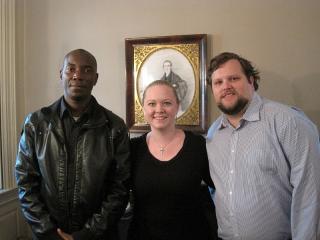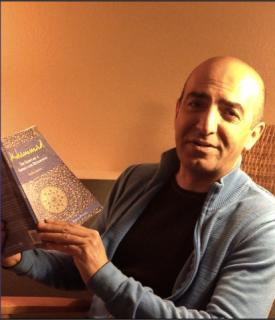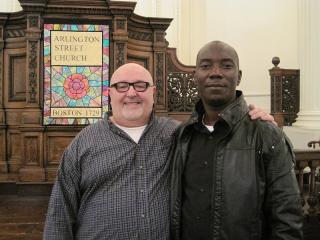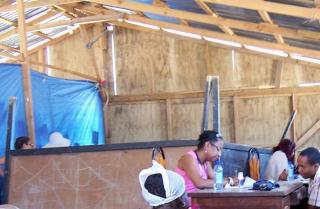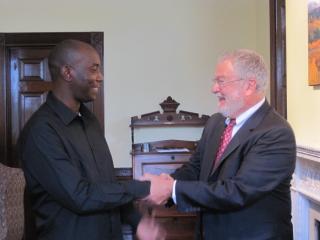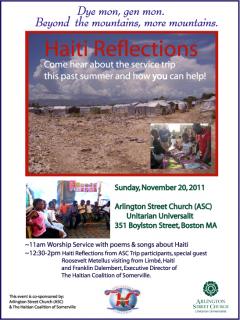Two church groups recently went to Haiti in July, each for a week of service. The first group, from Arlington Street Church in Boston, went to work at a school in a camp. The second group –including participants from the First Parish Church in Cambridge – went to provide medical services at the same camp. The following blog post is about both groups.
From July 12th-19th, four of us went to Haiti from the Arlington Street Church with Franklin Dalembert, the Executive Director of the
Haitian Coalition from Somerville MA. We worked and played at a school with about 80-100 kids who were mostly orphaned from the earthquake. The school was started by “Father Fredy,” a Catholic priest, in a camp near Port Au Prince. Below are reflections from several of the trip participants.
Reflections from Haiti
By Peter Lowber, member of Arlington Street Church
Franklin’s House
We stayed at Franklin’s house, which is about a six minute walk from the camp. Behind the gate at the dirt road in front of Franklin’s property is a yard of stones with a moving van sitting in the middle. Behind this yard sits Franklin’s house: a large concrete building—with several bedrooms and a living room area and an area where we ate our meals. Electrical wiring and windows are still waiting. Franklin bought the property in 2002. The property is lined with trees bearing all sorts of fruit including lush mangoes—all of which Franklin planted a while ago.
I had to sleep with a sheet over my head to keep out the mosquitos. A big rooster sat in the tree just outside my window—crowing every half hour from 1:30 AM on!
Franklin had a great team at the house: Toussaint the cook, Roosevelt our translator (Creole is not just like French!), Bernard who gave us security, and Joab who drive us around.
The First Day: The Eviction
July 13th — Today we went to the camp near Franklin’s house. On June 6th a violent storm struck with hurricane like winds and a torrential downpour. A wall of water surged through the camp destroying many tents, drowning scores of people. Father Fredy’s school and chapel (a wooden structure) and a large tent that also served as the school was swept away. A few weeks before we arrived, a plywood structure was erected—which serves as the chapel and school today.
We walked down past the school past the Aristide University dorms (two rectangular buildings now housing people who lost their homes in the quake). We came across a few UN soldiers with submachine guns, a moving truck, and people’s belongings piled up beside the truck. A man in charge of the IOM (the UN International Organization for Migration) stopped me and asked me who I was and what I was doing there. I motioned to Franklin to come over. The IOM guy said we shouldn’t be in the area. Franklin replied that it was his country and he had a right to be there unless the UN had declared this an interdiction zone (which the UN had not). The UN guy who had stopped me did not want me—an American “gringo”—to witness what was going on. An argument ensued for a few minutes, and a crowd of over twenty people surrounded us. They were telling us what was happening.
The UN was evicting 400 people from the Aristide dorms. They said they were giving each family $9,000, but in fact provided each family with two by fours and canvas covering—to build very small dwellings in a space isolated from the camp. The cost of each dwelling is probably less than $200—so where is the rest of the money going? The people showed us around their camp—which consisted of a couple hundred tents erected after the June 6th flood. One of the men—a teacher in his early thirties—showed me his tent, hardly big enough for his wife and young daughter. The people who told us about the eviction wanted us to report the event back to the U.S.
Ironically, last night it thundered and lighteninged and poured—it was the first rain since June 6th. Today we saw women washing everything in their tents because things were wet and muddy.
The UN: An Occupation Force
We saw UN troops with submachine guns in trucks and on the roads to Port au Prince. There are over 10,000 UN troops in Haiti—first put there by the US when Aristide was kidnapped in 2004 and sent to South Africa by Bush. People in Haiti call the UN an occupation force. The UN troops get paid way more than the Haitian police. Why not bring peace and water rather than guns and intimidation?
The School
The kids are to die for! They are great kids- very happy to see us. About 80-100 came every day we were there. It’s actually “summer camp”- as school starts again in September. The school, which also serves as a chapel, sits right at the entrance to the camp from the road from Franklin’s. The school is surrounded by mounds of rubble formed by the June 6th flood. Initially, we were expecting to help build a new school building—for which we had a blue print. But since no one among the camp community has title to the land, it makes so sense to invest in a building there which could be taken away at any moment.
Fortunately, Laura and Sharran—the two women in our group from ASC—have had lots of experience with kids and they came prepared with magic markers, paper, sewing materials, games. So they made up projects and Dave and I—the other two in our group—followed along. Sharran had the kids trace their hands and fill them in with any design using magic markers. Soon the plywood walls were transformed with colorful hands. And Laura had the kids cut out fabric and sew letters for a banner “Timoun Lespwa”—“Children of Hope”. (see the pictures). We hung the banner—which had a purple translucent color that shown through the light—just below the chapel banner.
My role became “athletic supervisor”—as I made up rules for a “ring toss” game that the kids loved. The kids also had a “soccer game” with a little ball we had—they will play soccer with anything that moves and their skills in controlling the ball are amazing.
Roosvelt was with us the entire time and he translated for us. There was also Lucdanse – one of the teachers—who was fun and who had a calming presence with the kids.
On the second day a couple of kids came up to me asking for water. I suddenly realized there was no water and none was coming. So we paid $15 for enough water for all the kids; the price seemed exorbitant but we didn’t argue. The next day the kids were scheduled to leave the school with no lunch. So we raised $35 amongst ourselves to buy the kids lunch.
What is really disturbing is the absence of any NGO or non profit group from the camp. What can possibly be the excuse for them not showing up where the need is greatest? With all the billions raised, where has all that money gone?? We heard from Franklin that the NGOs bought up desperately needed housing in better off areas for their organizations—which not only deprived locals of housing but also raised the prices in the process.
Mountain Trip
David came up with an idea to rent a bus on Saturday and take the kids on a trip up the mountain. We took 30 kids up to Fort Jacques. It took us 2 hours (a trip without traffic –which is never the case—would take 30-40 minutes). It was a slog and I felt bad for the bus driver. But the kids were excited. They hadn’t been out of the camp since the earthquake on January 12, 2010, and they had never even seen the mountains. They gawked out the window and they sang Haitian songs—one of the kids, about ten years old—played the bongo drums (he’s a natural and could play all day long). You should have heard their singing—to me it sounded like some African songs I have heard. High pitched, very strong, melodic rhythmic sound. Fort Jacques was built overlooking Port Au Prince by the Haitian Republic right after the slave revolt in 1805 to protect against a French or colonial attack. Being in the mountains was a relief. It was cool in the low 70s and felt like the A-C had been turned on!
Sunday Service
In the “chapel” at the camp- Over 250 people and kids were there! Standing room only. It was packed. Father Fredy had a sound system with background rock/jazz, and a live sax player, with two electric guitars and our 10 year old playing the bongo drums. The kids sat in front on the right and sang their hearts out- with the adults. The music was awesome- again a lot of it sounded African to me. Very strong, uplifting (not like some of the dull hymns we UUs have…). The spirit gives us strength as we return to our country to carry forward. The service lasted about an hour and a half, and at the end, Franklin introduced each of us and we each spoke briefly (Sharran was really eloquent!! and made a good connection…).
Trip to Port Au Prince
On our last night, Father Fredy drove us to Port Au Prince. We left at 5pm and it took about an hour and a half to get there (without traffic it’s about 25 minutes). There’s a lot of diesel fuel to choke on. We arrived just before sunset. UN troops with sub machine guns have a threatening presence everywhere. Seeing Port Au Prince brought it all into focus. The utter devastation is overwhelming. Rubble, buildings crushed, disappeared. The huge cathedral reduced to a lattice-work of concrete edifices that are the only remnants…a reminder of the many many people that died on that spot on January 12th.
The huge palace stands with sections sunk and crushed. All the bureaus and departments opposite the palace (erected by Duvalier to bring them physically directly under his control) disappeared. Hundreds and thousands of tents sit side by side without a space between them. Bernard saw the palace fall. A tall, very strong man, broad shouldered- a very sweet person—Bernard of course couldn’t reach his family (his eleven year old daughter, her mom and his mom), who lived outside Port Au Prince. So Bernard walked for 24 hours through the rubble and the utter disaster until he reached the spot where his house had been. Fortunately his family had survived. They lived on the third floor—which collapsed on top of the two lower floors killing all seven people below. Bernard also lost his cell phone business which was crushed in Port Au Prince.
As we drove out it got dark. There were many people on the streets escaping from their stuffy tents—with no where to go. But there were no kids and no street likes. It was dark—except for a few temporary lights put up after the quake.
What Can We Do Next?
Father Fredy showed us his five year plan for the school and the kids. The most immediate need is to get a house for 30 kids, then expand to house another 30 kids. The idea is to get as many kids as possible out of the camp. In addition, a major goal is to build a school—but that requires raising money to buy land and build. The immediate plan is to rent a house to house 30 kids and 4 adults. In the future- the hope is to own the housing. Fredy showed us a place he hopes to rent.
At first we thought it was too small. But Sharran—who has had experience with small living spaces in the Mideast—suggested that Fredy buy sponge like beds (instead of cots) that can be taken up during the day and replaced with portable tables. So the space can be multi functional. We agreed that the money we raised at our April fund raiser should go towards the rental cost of the house (instead of building the school which is not feasible at this point). We plan to do more fund raising in Boston to support Fredy’s five year plan.
Please help us!
You can contribute by sending a check made out to “
the Haitian Coalition,” 268 Rear Powderhouse Blvd 17C, Somerville, MA 02144.
Haikus from Haiti
By Laura Evonne Steinman, RE/Artist-in-Residence at Arlington Street Church
Creating art in the mist of rubble. Backing up bags and walking into the camps with collected bottles and beads, its amazing how even just one crayon or sewing needle can transform ones heavy heart into a smile and deep joy.
It was a blessing to share this artistic time with all the children, youth and adults using many recycled materials around the camps, plastic bags, rocks, trash, bringing those elements to life in a way that brought the trash, the rubble into treasures!
As the Religious Educator / Artist in Residence at ASC, I most definitely will be sharing my stories and experiences with the kids we have here in Boston, teaching them I’ve got peace like a river in Creole and working to build connections even in a land that seems so far, but is so close to my heart.
In addition to her dual roles at ASC, Laura is also an art instructor. Below are her reflections, in haiku form, as well as photos and a video from Haiti.
fights over plastic
fill thirsty mouths hungry
swarm i’m in-between
children in the breeze
pass rubble boarders thirsty
eye watering dry
working together
different voices harmony
vision so holy
each of us shinning
brightly together sparkle
across the sea, hope
each day like a week
crayons, rocks, trash together
no clocks, phones, water
Sunset sways round green
Nightingail Polish Dom, Mon
Dreams between morning
Dom- home in Polish
Mon- Mountian in Creole
hum, taste filled morning
quiet rooster rejoices
soul breeze top peaceful
A day of a table:
Cheese and eggs am chickens and coffee.
Dominos, prescription meds and blood pressure taking.
Laughy tafty, soda – cut squares of while fabric, hands together.
Banana warm drink by generator light, smiles – community.
[youtube x866jHjx1lM]
Lending Aid to Haiti
by Linda Cundiff, Chair of the Immigration Task Force at First Parish Cambridge UU
I have felt an affinity withHaiti, its people, art, music and spirituality for a long time. I once taught an RE lesson on Haitian voudou rituals, and by making beautiful prayer flags with fourth graders I became fascinated with the integrated spirituality of the Haitian people. Since the Haitian earthquake in January 2010, I was compelled to go toHaiti. After learning some Haitian Creole from Pimsleur’s language CDs I said “M vle ale Ayiti” to any Haitian that would listen.
I started working closely with the Haitian Coalition of Somerville, a small non-profit service agency with strong ties to Haiti led by Franklin Dalambert. Through my role at First Parish Cambridge UU chairing our immigration task force, and through my job leading community health work at the Cambridge Health Alliance I joined their collaboration for a mission in Haiti. Other partners included the Arlington Street Church and Funto Salud, a Boston-based Dominican Republic NGO founded and led by Maria Moreno that does health missions in Haiti. Our community partners in Haiti were the priests and members of two churches/schools in Tabarre who let us adapt and use their space, spread the word about the clinics, and supported us in many ways; and Doctors for Haiti (an organization in Haiti of Cuban-trained Haitian doctors who volunteer with visiting medical mobile clinics on their days off).
We raised money and developed a trip to Haiti to build a school for children who were mostly orphaned by the earthquake, and to provide health care for them and the families that care for them. As Peter Lowber of Arlington Street Church describes in his blog (see it here link?) storms, flooding and evictions dramatically changed the feasibility of the school plan, and the focus for the week I was there became about providing medical and mental health support. We held five clinics in four days- over 1200 children and adults had a medical visit with a doctor. People waited in line patiently for hours in the hot sun, so grateful for the water that we provided.
It was an overwhelmingly huge project and we needed everyone on the team to help. Haitiwas a powerful lesson for me and the others on the team about being all you can be, stepping and stretching up. The resources are so limited everyone’s skills are needed and tested and so appreciated. I had planned to be part of the team that did supportive arts projects with kids and families, along with Laura Evonne Steinman, DRE at ArlingtonStreetChurch, and with two mental health clinicians from Cambridge Health Alliance who do community trauma and victims of violence work. Maria Moreno became an awesome Clinic Administrator – she facilitated everything calmly and competently. Two alternative practitioners, members of Spiritual Church of Swampscott, and an HIV community health educator completed the team and did double or triple duty where needed. We also worked closely with fabulous local interpreters provided by Franklin who became essential team members- registrars and pharmacy assistants.
It turns out that my long dormant nursing skills were needed way more than my arts and crafts skills- I triaged and screened patients, and coordinated care of sick patients with the doctors and supported the pharmacy. We brought a lot of medications and supplies donated by CHA and other groups- but as the doctors in Haiti were unfamiliar with them the social workers and interpreters quickly became skilled pharmacists!
We became a well-oiled team, processing 150-500 patients in each clinic. We were joined by a Cambridge Health Alliance internist (Dr. Malou Jean-Baptiste) and other Haitian staff who were there on vacation. A nurse, psychologist and a pharmacy student from Doctors Without Borders came one day and on two days another nurse, unemployed and living in the camp just showed up to help. A mobile medical team from Puerto Rico showed up one day, bringing additional needed medicines and
a singing dentist who was a huge hit as dental care is even scarcer for the poor inHaiti as it is here.
I had read extensively in recent months (including Paul Farmer’s new book) and talked with many Haitians about the dire needs and lack of infrastructure for health care and public health. The reality of meeting severely ill patients who could not get care was a completely different experience. We saw patients with extremely high blood pressure with stroke symptoms, advanced breast cancer, a gangrenous finger- and there was nothing we could do- there were no local hospitals they could go to and it was doubtful that when they could get to a facility that there would be the care they needed due to cost and long waits. The children did not have access to any routine care or immunizations, and except for some malnutrition and parasites they were amazingly healthy.
The CHA mental health clinicians developed a list of resources for women who have suffered violence, and shared these resources with the church leaders. They led a group at the camp after clinic one day. They offered a supportive space, an opportunity to create beautiful scarves, and asked the women if they would like to talk about any trauma- the earthquake, violence against women etc. They chose to share their stories of experiencing the earthquake- the way many Haitians have everywhere have been processing this extraordinary community trauma. Then they sang together, so beautiful and touching.
I am very grateful to our local leader and partner Franklin Dalambert for his vision to bring folks who care to his grassrootsHaiti. His house in Tabarre is home base for many projects he is facilitating in Haiti, with constant visitors on various missions. We felt grounded in the real Haiti- water and power limitations, the difficulties of maintaining and repairing essential small engines, security issues and the ubiquitous barrier of traffic. Now I finally understand and appreciate “Haitian time”.
We found we became part of a fellowship of those who helpHaiti-we met scores of Haitian-Americans, Americans from all over the country, and teams fromCanada, andEngland. We greeted other warmly in airports, on the beach and atFranklin’s house, sharing stories and supporting each other. Everyone was touched byHaitiand her extraordinary warm and spiritual people.
Franklin said we would be changed by what we experienced and he was right.
M t’ale Ayiti epi m te chanje.
We are planning to go back, and welcome everyone with all kinds of skills who feel they want to help to join us. To participate in planning for next years trip contact the Haitian Coalition at 617-625-6400, or contact me at
immigration [ at ] firstparishcambridge.org. Please support the Haitian Coalition’s mission in Haiti by
making a donation.
Upcoming Related Events
